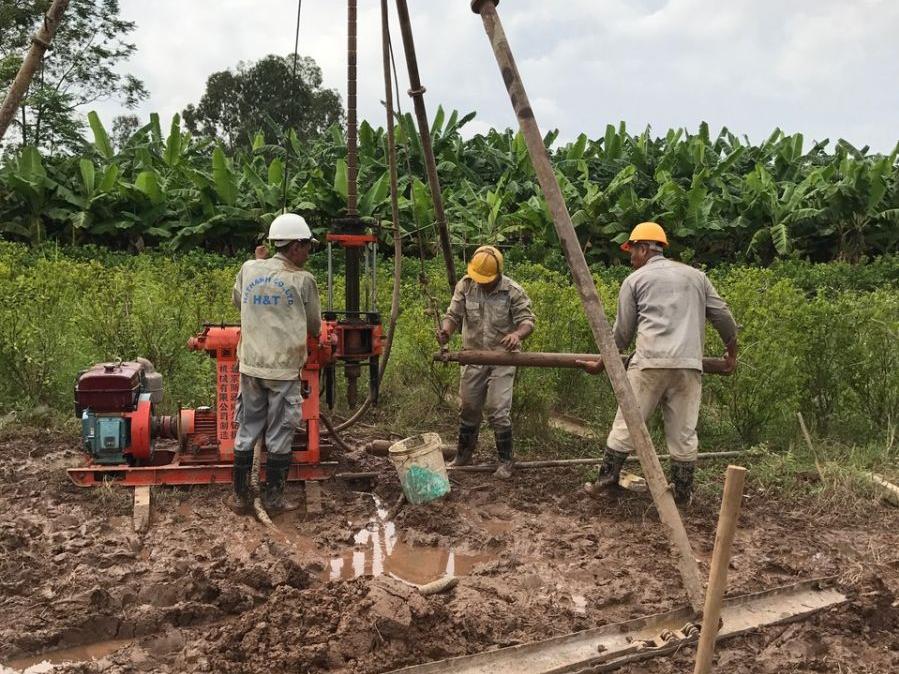News
11.03.2020
Underground food sources enable bacteria to release arsenic into groundwater
Tübingen University researchers find organic material in deep sediment layers in Vietnam – New knowledge first step to combatting groundwater contamination
Toxic arsenic in groundwater is a huge problem for more than a hundred million people worldwide, especially in Southeast Asian countries such as Bangladesh and Vietnam. The arsenic is released by the activity of microorganisms. A team of researchers in the field of geomicrobiology led by Professor Andreas Kappler from the University of Tübingen has now shown that these bacteria do not use food sources from the earth's surface, as was previously assumed, but from deep layers of rock. This new knowledge about the major pathways and processes of arsenic release will help to more precisely predict future drinking water contamination and prevent it if possible. The study has been published in the journal Environmental Science and Technology.
Large quantities of arsenic-containing iron minerals can be found in the subsoil of many regions of Southeast Asia. Aquifer sediments are home to communities of microorganisms, which can dissolve iron minerals and release the toxic arsenic. To do this, the microorganisms need organic material as food. "Previously, it was assumed that organic material from the surface – such as plants or algae from ponds and lakes – enables the microorganisms to dissolve the arsenic-containing iron minerals and thus release the arsenic," says Andreas Kappler. However, in many groundwater systems there are indications that the organic material does not penetrate down from the surface to the arsenic-containing layers.
In the new study, the Tübingen scientists, together with colleagues from Zurich, Karlsruhe and Berlin, investigated the relevant processes at a village with arsenic-contaminated water, in VanPhuc, 15 kilometres south-east of Hanoi in Vietnam. There, drill cores were taken of fresh subsoil material from depths of more than 40 meters. The research team examined how much organic material was present in the deep rock layers, where it came from, and whether the microorganisms present could use it as a source of food and energy. Experiments carried out in the laboratory in Tübingen enabled the researchers to identify the metabolic processes taking place – and what the various bacteria eat.
Old organic material from deep sediment layers
"The organic material naturally present in the samples appears to originate from old mangrove forests. It was deposited and preserved in the layers of sediment which contain arsenic," says Kappler. Microorganisms are apparently using it as a food source, thereby releasing the arsenic into the groundwater. A comparison of the results from the laboratory experiments with the arsenic concentrations measured in the water from the study area showed that the microbial processes, fueled by organic material from deep layers, could explain the high levels of arsenic found in the water. The influence of organic material from the surface may be much less than previously thought.
"We need to understand which microbial processes lead to the release of arsenic and the pollution of the water," says Professor Kappler, who headed the study. The lead author of the publication, Martyna Glodowska, adds: "It is a crucial step in this process that we have been able to identify the food source of the active bacteria in the subsurface.”
Publication:
Glodowska, M., Stopelli, E., Schneider, M., Lightfoot, A., Rathi, B., Straub, D., Patzner, M., Berg, M., Duyen, V.T., Kleindienst, S., Kappler, A. (2019) Role of in-situ natural organic matter in mobilizing As during microbial reduction of Fe(III)-mineral-bearing aquifer sediments from Hanoi (Vietnam). Environmental Science and Technology, https://dx.doi.org/10.1021/acs.est.9b07183
Contact:
Prof. Dr. Andreas Kappler
Faculty of Science
Center for Applied Geosciences
Phone +49 7071 29-74992
andreas.kapplerspam prevention@uni-tuebingen.de
Contact for press:
Eberhard Karls Universität Tübingen
Public Relations Department
Dr. Karl Guido Rijkhoek
Director
Janna Eberhardt
Research Reporter
Phone +49 7071 29-76753
Fax +49 7071 29-5566
janna.eberhardtspam prevention@uni-tuebingen.de
www.uni-tuebingen.de/en/university/news-and-publications

